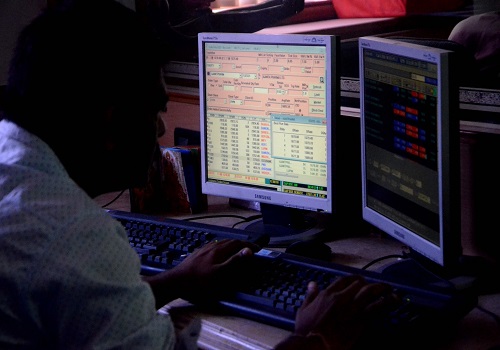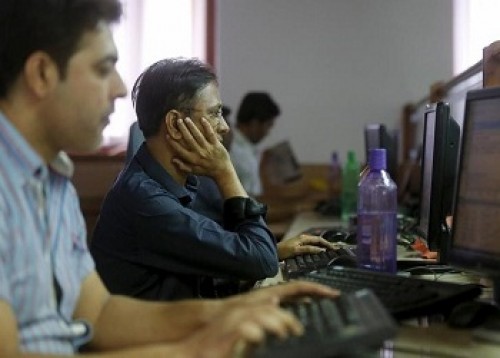Benchmarks extend southward journey for second straight day

Follow us Now on Telegram ! Get daily 10 - 12 important updates on Business, Finance and Investment. Join our Telegram Channel
Extending previous session’s southward journey, Indian equity benchmarks ended with losses of over a percent, with frontline gauges breaching their crucial 58,800 (Sensex) and 17,500 (Nifty) levels, dragged by heavy selling pressure in metal, realty and basic materials stocks. Benchmarks made negative start and remained under pressure throughout the session amid weak global cues. Traders remained anxious as the Reserve Bank of India (RBI) data showed that the country’s foreign exchange reserves fell $2.238 billion to $570.74 billion in the week ended August 12. Domestic sentiments also got hit with labour ministry stated that retail inflation for farm and rural workers increased to 6.60 per cent and 6.82 per cent, respectively, in July mainly due to higher prices of certain food items. In June retail inflation for farm and rural workers stood at 6.43 per cent and 6.76 per cent respectively.
Domestic sentiments remained pessimistic in late afternoon deals, amid reports that with the price situation remaining at 'unacceptably and uncomfortably' high level, members of the RBI's Monetary Policy Committee underlined the need for preventing upward drift of inflation and bringing it down to the target band, as per minutes of its recent policy meeting. Traders also reacted negatively to External Affairs Minister S Jaishankar’s statement that India faces a challenge to ensure that its economic interests are well protected and its consumers are shielded to the extent possible from the enormous jump in the oil prices in the wake of the Ukraine conflict. Traders overlooked the finance ministry's monthly economic review stating that India is better placed on the growth-inflation-external balance triangle for 2022-23 than it was two months ago, on the back of government policy response and the RBI’s monetary policy actions. Meanwhile, foreign investors have shown tremendous enthusiasm for Indian equities and have infused close to Rs 44,500 crore in August so far amid softening of inflation in US and falling dollar index.
On the global front, European markets were trading lower with fears of aggressive monetary tightening and concerns over Europe's energy crisis keeping investors nervous. Asian markets settled mostly lower on Monday as investors awaited a slew of U.S. data and Federal Reserve Chair Jerome Powell's keynote address at the Kansas City Fed's two-day annual economic symposium this week for fresh clues on the economic and rate outlook.
Back home, jewelry industry stocks were in watch as the government data showed that India's gold imports rose 6.4 per cent to $12.9 billion during April-July this fiscal due to healthy demand. There were some reaction in real estate industry stocks with a private report that India's residential market is expected to sustain demand momentum despite rise in mortgage and property rates as sales this year across the top 7 cities are likely to breach pre-pandemic level of 2.62 lakh units.
Finally, the BSE Sensex fell 872.28 points or 1.46% to 58,773.87 and the CNX Nifty was down by 267.75 points or 1.51% to 17,490.70.
The BSE Sensex touched high and low of 59,402.50 and 58,705.11, respectively. There were 2 stocks advancing against 28 stocks declining on the index.
The broader indices ended in red; the BSE Mid cap index fell 1.80%, while Small cap index was down by 1.17%.
The top losing sectoral indices on the BSE were Metal down by 2.69%, Realty down by 2.47%, Basic Materials down by 2.44%, Consumer Discretionary down by 2.01% and Auto down by 1.92%, while there were no gaining sectoral indices on the BSE.
The top gainers on the Sensex were ITC up by 0.64% and Nestle up by 0.28%. On the flip side, Tata Steel down by 4.50%, Asian Paints down by 3.51%, Wipro down by 2.96%, Sun Pharma down by 2.90% and Larsen & Toubro down by 2.87% were the top losers.
Meanwhile, expressing optimism over the country’s overall position, the finance ministry's monthly economic review said India is better placed on the growth-inflation-external balance triangle for 2022-23 than it was two months ago, on the back of government policy response and the Reserve Bank's monetary policy actions. On the price situation, the review said in absence of any further shocks, the downward movement of global commodity prices along with the RBI's monetary measures and the government's fiscal policies are expected to cap inflationary pressures in the coming months. It noted that softening of inflationary pressures in India is further on the anvil as the prices of important raw materials such as iron ore, copper and tin that feed into the domestic manufacturing process, globally trended downwards in July 2022. Headline retail inflation eased to 6.7 per cent in July 2022 from 7.01 per cent in the previous month.
It further said the Index of Industrial Production (IIP) and eight core industries points towards strengthening of industrial activity, while PMI Manufacturing touched an 8-month high in July with marked gains in growth of new business and output. On the external front, it said, post the outbreak of the Russia-Ukraine conflict, an increase in uncertainty among investors has led to capital outflows, not just from India alone but from the group of emerging market economies (EMEs) as a whole. Thus, apart from India, the currencies of several EMEs also depreciated against the US dollar. Between January and July of 2022, foreign portfolio investors pulled out $48.0 billion from EMEs.
It added that global investor confidence in India's economic landscape is further endorsed by net foreign direct investment (FDI) inflows remaining robust at $13.6 billion in Q1 of 2022-23, as compared to $11.6 billion during the corresponding period of the last year. It said India's growth outlook for 2022-23, though lower than projections made before the outbreak of the conflict in Europe which resulted in sharply higher price for crude oil and other essential commodities, is still comfortably high and confirms the recovery of animal spirits and economic growth from the pandemic-induced contraction in 2021-22. Observing that private sector and banking sector balance sheets are healthy and there is appetite to borrow and to lend respectively, the report said barring further adverse shocks to commodity prices and thus India's terms of trade, economic growth will consolidate and retain its momentum into 2023- 24.
The CNX Nifty traded in a range of 17,690.05 and 17,467.35. There were 5 stocks advancing against 45 stocks declining on the index.
The top gainers on Nifty were Tata Consumer Product up by 0.83%, Coal India up by 0.64%, ITC up by 0.59%, Britannia Industries up by 0.34% and Nestle up by 0.20%. On the flip side, Tata Steel down by 4.41%, Tata Motors down by 3.70%, Adani Ports &SEZ down by 3.65%, Asian Paints down by 3.63% and Divi's Laboratories down by 3.19% were the top losers.
European markets were trading lower; UK’s FTSE 100 decreased 18.27 points or 0.24% to 7,532.10, France’s CAC decreased 77.24 points or 1.19% to 6,418.59 and Germany’s DAX decreased 218.68 points or 1.61% to 13,325.84
Asian markets settled mostly lower on Monday tracking losses of US stocks on Friday amid uncertainty over the US Fed's rate-hiking path. Investors are awaited Federal Reserve Chair Jerome Powell's keynote address at the Kansas City Fed's two-day annual economic symposium this week for fresh clues on the economic and interest rate outlook. Meanwhile investors are also fretted about potential recession risks globally. However, Chinese shares gained as the country's central bank PBoC cut its key lending rates again to boost an economy battered by Covid-19 lockdowns and a property market crisis.
Above views are of the author and not of the website kindly read disclaimer










Tag News

Weekly Market Analysis : Markets strengthened recovery and gained nearly 2% in the passing w...



More News

The Markets are expected to open lower today as trend in SGX nifty - ARETE Securities





 320-x-100_uti_gold.jpg" alt="Advertisement">
320-x-100_uti_gold.jpg" alt="Advertisement">




